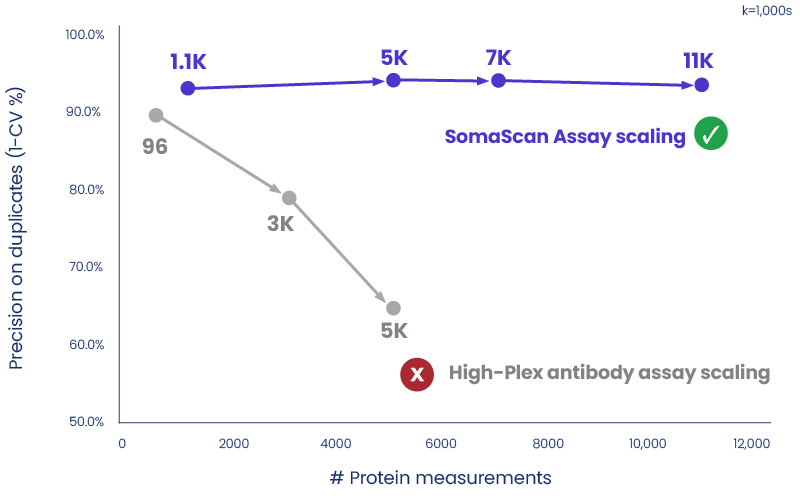SomaScan Assay case study:
Uncovering ocular biomarkers: Advancing novel diagnostic and therapeutic development with high-plex proteomics
The eye as a window to systemic health
How SomaScan Assay detects the most
proteins with the highest precision to uncover ocular biomarkers
The eye is a complex organ that serves as one of our primary sources for interacting with our environment. Not only can our eyes provide a broad view of what’s around us, but they can also provide a broad view into our health. Many systemic diseases present as ocular symptoms that can precede or accompany other clinical indicators1. The ability to recognize and understand these ocular manifestations could enable earlier diagnosis and more effective management of systemic diseases.
Eyeing thousands of proteins for biomarker discovery with the highest scale and precision
The SomaScan® Platform measures 11,000 proteins in a wide variety of cell and tissue types, including ocular samples such as aqueous humor and vitreous liquid, crucial components of the eye that house a variety of cell types. In a 2023 publication in Cell by Wolf et al., cell-specific markers for over 15 cell types present in aqueous humor were identified through the SomaScan Assay proteomic profiling. In total, 1,920 cell-type marker proteins with highly specific expression in their respective cell type were detected.

*Source: Rooney, M.R. et al., 2024. Plasma proteomic comparisons change as coverage expands for SomaLogic and Olink. medRXiv.
Harnessing the combined power of SomaScan proteomic data and AI, Wolf et. al. developed a 26-protein model to predict the age of the eye. Of the 26 model proteins, five proteins had no prior known associations to aging and were reported for the first time in this study. Notably, 11 of the 26 model proteins are not included on the high-plex antibody platform, demonstrating how more proteins enable greater discovery.
Unlock the power of 11,000 protein measurements from just 50µL of aqueous humor
Unlock the power of 11,000 protein measurements from just 50µL of aqueous humor
An incomplete understanding of which cells drive disease reflects the difficulty in accessing intricate, dynamic human tissue. Liquid biopsies that capture locally enriched fluid offer an alternative solution to obtain valuable information that can enable development of better diagnostic and therapeutic strategies. Historically, proteomic analysis of aqueous humor has been challenged by its low volume and low protein concentration compared to vitreous liquid; however, Wolf et al. has demonstrated that the SomaScan Platform detects thousands of proteins in just 50 µL of aqueous humor. Successful detection of low-abundance proteins in minimal sample volumes is attributable to the exceptional dynamic range of the SomaScan Platform.
Additionally, due to sample type, many cell and tissue studies have a small sample number. In the study by Wolf et al., only 15 ocular samples were obtained from individuals with diabetic retinopathy, six samples from individuals with uveitis, seven samples from individuals with retinitis pigmentosa, and five samples from individuals with Parkinson’s disease. The SomaScan Platform offers a better chance of finding significant signals in small group sizes because of the platform’s low coefficient of variation (CV).
| The SomaScan Assay uniquely scales with 6x better precision than HP antibody assay |
||||
|---|---|---|---|---|
| SomaScan 11K Assay | SomaScan 5K Assay | High-plex antibody assay 1* | High-plex antibody assay 2* | |
| # Proteins | 11,083 | 5,284 | 5,420 | 3,072 |
| Median CV | 6.8% | 6.6% | 35.7% | 19.8% |
| *Source: Rooney, M.R. et al., 2024. Plasma proteomic comparisons change as coverage expands for SomaLogic and Olink. medRXiv. | ||||
| The SomaScan Assay uniquely scales with 6x better precision than HP antibody assay | |||
|---|---|---|---|
| SomaScan 11K Assay | SomaScan 5K Assay | ||
| 11,083 Proteins | 5,284 Proteins | ||
| 6.8% Median CV | 6.6% Median CV | ||
| High-plex antibody assay 1* | High-plex antibody assay 2* | ||
| 5,420 Proteins | 3,072 Proteins | ||
| 35.7% Median CV | 19.8% Median CV | ||
| *Source: Rooney, M.R. et al., 2024. Plasma proteomic comparisons change as coverage expands for SomaLogic and Olink. medRXiv. | |||
Translating proteins to a purpose with the SomaScan Assay
Utilizing the power of unbiased proteomics can aid in understanding disease mechanisms, ultimately supporting novel diagnostic and therapeutic development. Studying diseases both specific to the eye (retinitis pigmentosa, diabetic retinopathy) and not specific (Parkinson’s disease), Wolf et al. used the SomaScan Platform to uncover novel strategies for molecular monitoring and drug development for these conditions. Proteomics can identify key connections in systemic disease that may not appear obvious. The more proteins that can be reliably and precisely examined for connections, the stronger our understanding of how these diseases manifest and progress will become.
REFERENCES
- 1. Kumar MJ Jr, Kotak PS, Acharya S, Nelakuditi M, Parepalli A. “A comprehensive review of ocular manifestations in systemic diseases.” Cureus. 2024 Jul 29;16(7): e65693. PMID: 39211636.




